MAGICAL TOWNS IN YUCATAN
Magical Towns of YUCATAN
Yucatán is a region of the country that protects great natural and cultural treasures that are very important to the country, two places that perfectly exemplify the importance of Yucatán in the history of Mexico are its magical towns, Izamal and Valladolid, two destinations that in its streets they protect all the magic of Yucatan.
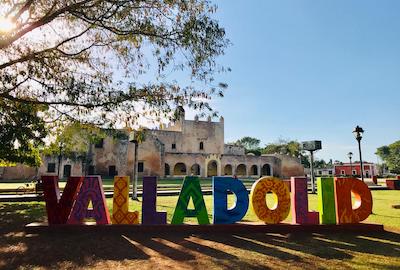
It is a beautiful colonial city, located strategically between the city of Merida (two hours) and the city of Cancún, 40 km away of the majestic Chichén Itzá. Today it is now known as “The Eastern Capital of the Maya”. An elegant colonial town distinguished by the hospitality of the people. The main attractions are: Convent of San Bernardino, a building of majestic dimensions and superb Franciscan style and the Church of San Gervasio. Valladolid offers good hotels and restaurants.
The Magical Town of Valladolid is a beautiful colonial city, with a lot of color and magic, in addition, it is a strategic place to visit other destinations in Yucatan and in general the Mayan World.
Tourist Attractions in Valladolid
Palacio Municipal (City Hall)
Built in the 16th Century, it was reformed in the 19th Century. There are nice murals in the second floor depicting the history of the city.
Catedral de San Gervasio (Cathedral of San Gervasio)
The cathedral was completed in1545 then destroy and rebuilt in 1702. It has a beautiful facade with detailed stonework.
Museo de San Roque
It was the first hospital in the village, and work this way during the 16th to 18th Century. Today is a museum with an interesting exhibit of archaeological pieces, traditional Mayan medicine and handcrafts of the region.
Iglesia de la Candelaria
The Candelaria Virgin is the Town’s Saint and each February 2nd there is a big celebration with cultural, gastronomic, livestock and artistic activities. The complex has a beautiful entrance supported by arches.
Iglesia de Santa Ana
It was built in the 16th Centuray, and has a nice stained glass in the facade.
Cenote Zaci
It is located in the middle of the town, near the main plaza. Today is a park, and steps lead down into the cavern mouth of this huge dramatic sinkhole with fascinating patterns of light. This cenote is about 260 ft deep and it has a diameter of 150 feet.
Iglesia de Santa Lucía
Built at the beginning of the 17th Century, the church has a façade based by a simple reed-mace with three bell columns, and the frame doors are shaped on stoned with vegetal figures.
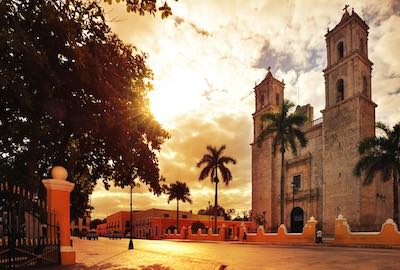
Convento de San Bernardino de Siena
Construction was started in the year 1552 by the Franciscans, is one of the most beautiful buildings of the colonial era. The highlight is the church’s giant altarpiece in polychrome wood. On the left-hand side a door leads to a two-story cloister of massive stone colonnades, housing. The convent also has a sinkhole named Sis-Há.
Casa de los Venados (House of the Deer)
It is an 18,000 sq. ft. private home/museum of Mexican folk and contemporary art with over 3000 pieces of art. The house is owned by John and Dorianne Venator and displays one of the largest collections of folk art in private hands. Tours (in English and Spanish) are given most days at 10:00 hrs, but advance reservations are advised.
Start your walk in the central square, preferably in an hour when it is not too hot and of course something you must do at every opportunity during your visit to Yucatan is to enjoy Yucatecan food.
Valladolid is traditionally known as “The Capital of the Mayan East” for its imposing colonial buildings, among which are the Church of San Gervasio, the Convent of San Bernardino de Siena, the Municipal Palace, the Museum of San Roque and the Ex loom de la Aurora, among others.
Valladolid is divided into 6 main neighborhoods in addition to its historic center. The latter concentrates the hotels and buildings of greater importance in the place. Those who spend a season in Valladolid usually have one of the most important tourist experiences of their lives.
Cenotes in Valladolid
Cool off in one of the cenotes in this community and its surroundings, among the most famous cenotes are the following:
- Cenote Zaci
- Cenote Xkeken
- Cenote Samulá
- Cenote Oxman
- Cenote Suytún
- Cenote Hubiku
Visit the Municipal Market “Donato Bates”, Here you find fruits, vegetables and many other products of the region in a local environment to really get to know the culture and its daily manifestations.
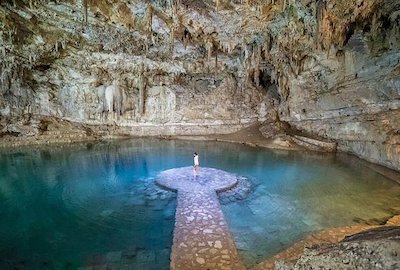
Two important events in Mexican history took place in Valladolid. One of them is the “Caste War” in 1847 and also the first revolutionary spark in 1910.
Valladolid has a strategic location in this area of the Yucatan peninsula. the perfect place to stay and take tours to know the best of the Mayan world.
Near Valladolid there are incredible places where the magnitude of the Mayan culture is evident, such as Ek-Balam, Chichen Itzá, Tulum or Coba and also important cities of the viceregal era such as Izamal or Tihosuco.
Valladolid is a must on the Mundo Maya route, since it is located between Mérida and Cancun, approximately two hours from each and only 40 kilometers from Chichén Itzá.
Either by car or by bus, transport to Valladolid is frequent, of excellent quality and at affordable prices.
It is located right in the center of the peninsula, 72 km to the east of Merida. Located right in the center of the peninsula, 72 km to the east of Merida. It is probably one of the eldest cities in Yucatán. Actually known, as the “City of the Hills” because of the archaeological remains located in the town center. This gorgeous colonial city has buildings and beautiful old houses painted in white and ochre.
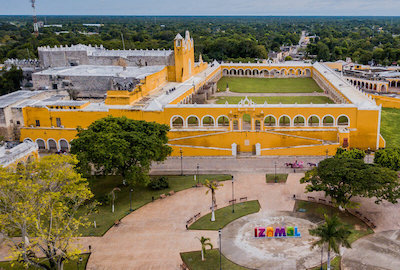
The Franciscan Monastery is famous for its majestic porticoes cloister, the largest in America. Beside the Convent is The Community Museum.
Izamal offers restaurants, nice hotels and handcrafts stores. First Magical Town of Mexico, its history, from its foundation to the present, is bonded to a strong religious tradition; this is because this site was once an enormous Mayan ceremonial center.
Its name is due to Zamná, “dew of the sky”, character of singular wisdom and mythical origin considered as an instructor and teacher of the Mayans.
This town built on 12 small hills that break the surrounding plain, still preserves the vestiges of its ancient and enormous power: cenotes of ritual sacrifice are found around. Of the ancient four white roads or sacbés, and that led to allied or subjugated cities, two can still be admired. Aké and Kantunil, satellites of this great Mayan city, are, on clear days, visible from the top of the Kinich Kakmó pyramid.
For the visitor, the cobblestone, stone and asphalt streets of Izamal require a long walk to extend the visual enjoyment to all corners.
Tourist Attractions in Izamal
Stroll through the Magical Town of Izamal and learn about its crafts
Walk the small streets of Izamal, and talk with the locals, take the opportunity to ask them about the attractions, the handicrafts and what they know about the place, the people are very friendly and will surely make your experience a very pleasant one. The people of Izamal know how to make dreams with their hands. Here the jewelery and saddlery works are of unequaled beauty: a hammock woven from henequen fiber for unforgettable naps; furniture and ceramics are also a good option for the visitor.
Centro Cultural y Artesanal Izamal
The museum exhibits magnificent handcrafts. It is located in the Central Plaza.
Visit the Archaeological Zone of Izamal
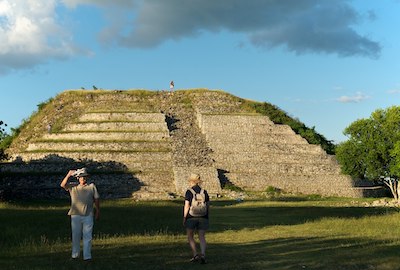
The pre-Hispanic city was occupied approximately from the year 300 before our era, until very close to the moment of the Spanish conquest, since in the chronicles of Fray Diego de Landa the greatness of its buildings is already related. Currently, the most important building is the Kinich Kak Moo temple or Great Pyramid, which stands out for its height. In its upper part there is a small square that possibly functioned to perform rites and ceremonies dedicated to the deity Itzamná. The base measures 200 meters, and rises 34 meters. With a volume of 700,000 cubic meters, this is the largest structure on the Yucatan Peninsula.
Participate in the Festivities in Izamal Pueblo Mágico
In June, after 13 laps, the party is done and the locals worship San Antonio de Padua. The atrium of the convent is tinted with rainbows. The songs are heard from the morning and when the sun has finished its journey, the Virgin of Izamal walks through the streets, blessings are asked, orders are promised and songs are offered for when her day arrives in December. By the 21st, the party is over, but in a respectful way, the summer equinox is celebrated.
Before December arrives, the dead have been celebrated and honored on November 1 and 2; Flowers slowly fade in the cemetery November 29 dawns with noise in heaven and prayers on earth; Multicolored and varied stalls are placed in the main streets and for nine days and nights, the 8th of December will be eagerly awaited to celebrate the Virgen de Izamal, the Virgen de la Purísima Concepción.
Tour the Temple of the Immaculate Conception and the former Convent of San Antonio de Padua
Three large ramps facing north, south and west serve as access to the monumental atrium, considered the largest in Latin America (with an area of almost 8,000 m2) that was completed in 1561. The facade of the temple is in the Plateresque style , while the choir window has a strong Moorish flavor; at the top a three-clear belfry opens.
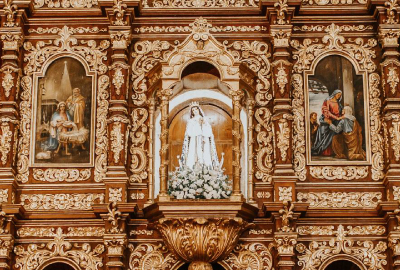
The interior is of a nave with barrel vaults and laceries in the presbytery, where you can see a late 19th century Neo-Gothic altarpiece that houses the sculpture of the Virgin of Izamal. It is located on streets 30 and 31.
The temple of the Immaculate Conception and the former Convent of San Antonio de Padua form an impressive complex raised on a pre-Hispanic platform that was part of the hill called “Pap-hol-chac”, which was practically destroyed by the Spaniards to build the convent complex, at the request of Fray Diego de Landa, between 1553 and 1561. The old convent of Izamal, of sober architecture and large dimensions, is located towards the north part of the temple.
In this place a light and sound show called: “The light of the Mayas” is presented on Tuesdays, Thursdays and Saturdays, at 8:30 p.m.
Rides in horse-drawn carriages
The visitors can take a charming ride down neat cobblestone streets, around the parks, squares and historical suburbs. They are located in the main plaza every day from 8:00 to 17:00 hrs.
Gastronomy of Izamal
Izamal’s cuisine has all the charm and wonder of Yucatecan food. The market or a good restaurant are an opportunity to entertain the palate with the exquisite mestizo touch of these lands: beans with pork, chaya with eggs, chicken stew, stuffed cheese, salbutes, panuchos, venison pipián, papadzules, sausage, cochinita pibil, joroches, mucbil pollos, pimes and tamales, are just a few of the dishes that can be enjoyed accompanied by xtabentun, balché, anise drink, posol with coconut or a fresh horchata. To finish with a sweet taste in the mouth, nothing better than yucca with honey, honey pumpkin, sweet potato with coconut, cocoyol in syrup, pumpkin seed marzipan, marshmallow, arepas, tejocotes in syrup or ciricote candy.
Map of Magical Towns of Yucatán
More Tourist Attractions in YUCATAN
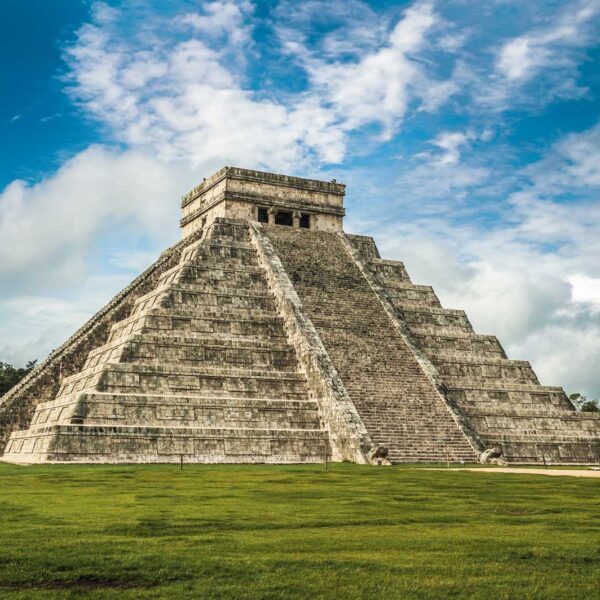
Chichen Itza
Chichen ltzá (the city on the edge of the well of the Itza), was the most important regional capital of the Mayan area in the years 750 to 1200 AD, a bridge between the Mesoamerican Classic and Postclassic periods. His remains, still well preserved, confirm the fame assigned to him by the chronicles and indigenous legends of Yucatan. Its vestiges show that the traditional Mayan civilization was enriched with other cultural currents of Mesoamerica.… Read More
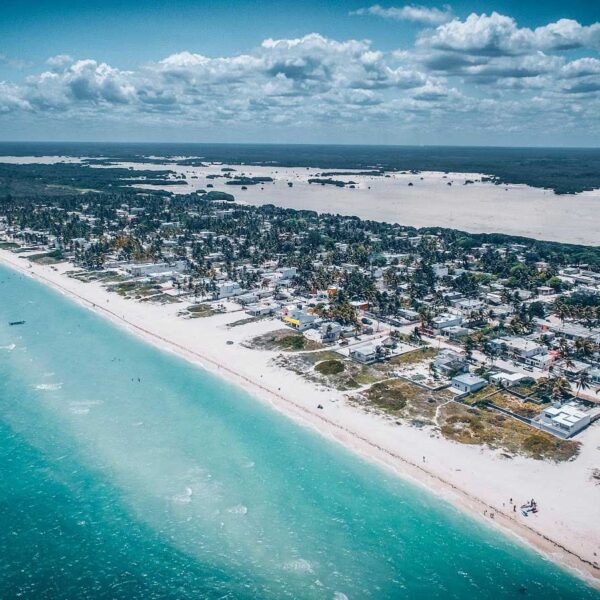
Beaches in Yucatan
There is a wide variety of beaches in Yucatan, ranging from Progreso, which is only 20 minutes from Merida, to more distant beaches such as San Felipe. They all offer a peaceful environment where you can relax, camp and enjoy nature, or practice various sports such as fishing, kayaking, SUP and many other water activities. Among the options that Yucatan offers, there are some that are true paradises such as Celestún and Río Lagartos where the sky is painted pink because they are the habitat of important colonies of pink flamingos. Most of them are wide white sand beaches and in several you can savor some of the delicious typical dishes of Yucatan.… Read More
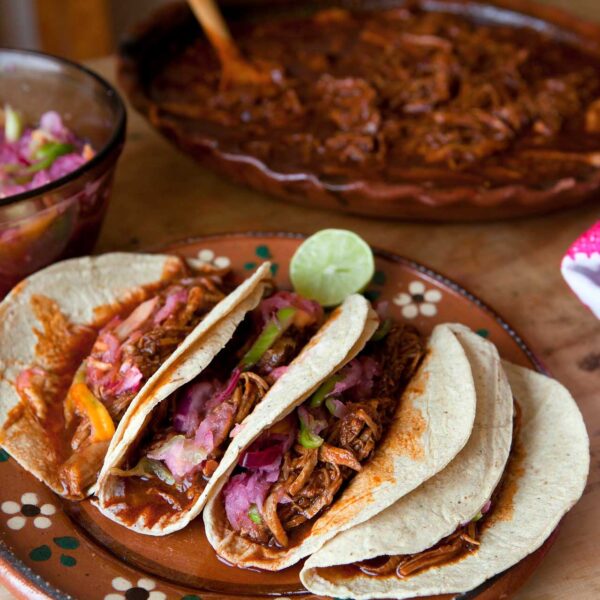
Gastronomy of Yucatan
The gastronomy of Yucatan has its origins in the traditional cuisine of the Mayans with some Spanish ingredients. Its dishes are well known for their particular aroma and flavor, because they are prepared with condiments such as oregano, sour orange, coriander and mainly different types of chili. Other ingredients are the famous “recados”, which are a kind of pasta with which a very characteristic flavor is given to meats, such as the black “recados” or the red “recados”, among others. The “recados” are simply various species of condiments and ground and mixed chilies that form a paste, and that are the main base of many Yucatecan dishes. So in addition to a trip through the incredible jungle landscapes of Yucatan, the cenotes, the archaeological sites, cities and towns, you should enjoy a whole gastronomic trip through the beautiful land of the Mayans.… Read More
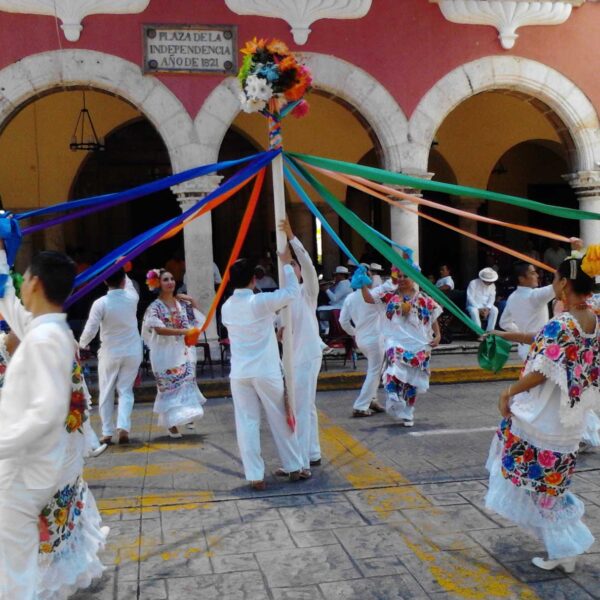
Traditions of Yucatan
The people from Yucatan integrate their beliefs, celebrations and ancient customs into their daily lives, and create a very special kind of magical syncretism. The handcrafts, the cuisine, the music, the folklore, and the traditions are irrefutable proof that Yucatan is a magic land with open, warm atmosphere, where visitors always feel welcome.… Read More
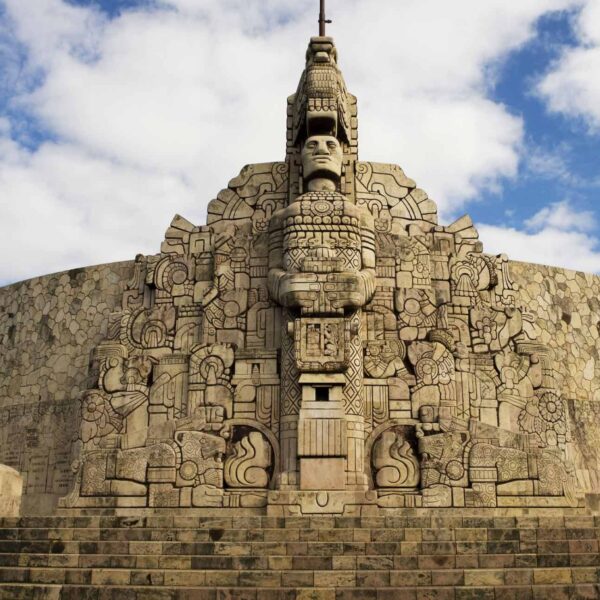
Merida
Merida is one of Mexico’s most important colonial cities, an architectural jewel traditionally known as “La Ciudad Blanca” (The White City). The Mayan World with the generous hospitality of its people surrounds it. It features traditional neighborhoods, tree-lined stately avenues, world class services, varied cuisine, night life and modern installations which guarantee your business success as well as an indelible memory of a unique experience. Mérida has become the “Medical Capital of the South-east Mexico” with a vast network of hospitals, clinics, laboratories as well as private and public doctor’s offices; the health care in the city is excellent and very affordable. Many doctors are English-speaking, often having done their training in the United States; the facilities are state of the art but cost less.… Read More
Guided Tours in YUCATAN
Flights & Hotels in YUCATAN
More Tourist Attractions in MEXICO

Beaches
On the Beaches of Mexico you can immerse yourself in the intense blue ocean of the Pacific bays, sunbathe on the shore of the warm and transparent waves of the Caribbean Sea in Quintana Roo or even rest on the beautiful coasts of the Gulf of Mexico. Mexican beaches hide wonderful secrets for the traveler. By visiting them, in addition to enjoying the excellent climate and water activities, you can discover splendid archaeological sites and interesting colonial cities without traveling long distances.… Read More

Gastronomy
The Gastronomy of Mexico has a great diversity of typical dishes, which is why it was recognized by UNESCO as Intangible Heritage of Humanity. The basic and representative ingredients of Mexican dishes are: corn, coriander, chili, beans, piloncillo, nopal and tomato. Mexican cuisine is also characterized by its sauces, which serve as an accompaniment to traditional dishes, prepared based on spices.… Read More

Archaeological Sites
The Archaeological Zones are the cultural past of every Mexican. You will be amazed at the ambient, nature and the environment that surrounds them. Climbing to the top or being around it will take us back in time to admire every detail. México is a country of culture and traditions, many of which we have inherited from the pre-Hispanic inhabitants of this vast territory, although it is true that there were more settlements in the central and southern part of the country, it is also possible to find some archaeological remains in the north.
… Read More

States Of Mexico
Mexico has an incredible diversity of landscapes, where the beauty of its beaches, internationally recognized, stands out. In its vast territory of coasts, there are beaches of unparalleled beauty, and colorful landscapes. A large network of first-class hotels and tourist services is available to visitors to these beaches. Mexico is also mystical places, dotted with archaeological testimonies inherited from its original inhabitants. Monuments made by the Mayas, Aztecs and Toltecs are located in magical landscapes, like lighthouses in an ocean of natural beauty. They offer visitors buildings that tell their history, and museums that collect their cultural heritage. And that keep alive ancestral traditions, in ceremonies and festivals, where you can enjoy cultural activities and entertainment.… Read More

Capital Cities
Folklore, gastronomy, literary culture, art and exhibitions, is what you will find in the capitals of the states of Mexico. To the north, colonial Mexico, Puebla, Guadalajara, Guanajuato, the Sonoran desert and the California peninsula. To the east Veracruz and the gulf. To the west Acapulco, Oaxaca and Tuxtla Gutiérrez. And to the south the Riviera Maya and the pyramids of Chichén-Itzá, Tulúm and Cobá in Yucatán, Palenque in Chiapas, the cenotes, and the Central American jungles.… Read More

Ecotourism and Adventure
Mexico is one of the best countries for Ecotourism as it has a great variety of flora and fauna, as well as a large number of refuges for extraordinary species. You can enjoy recreational activities of appreciation and knowledge of nature through contact with it, such as: stargazing, observation of natural attractions, wildlife and bird watching. Throughout México there are more than 176 protected natural areas, 5 of them considered by UNESCO as Natural Heritage of Humanity. Just for this and much more, we believe that Mexico is a Paradise for Ecotourism.… Read More

Traditions in Mexico
It is practically impossible to make a meticulous, and above all, accurate selection of the places to visit in Mexico. Each place that our country houses is unique and beautiful in its own way. Mexico, with its nearly 2 million km², has a large number of scenarios to offer, as well as endless activities to do. Do not lose your way and enter the places to visit in Mexico. In Mexico, apart from the beaches and its famous archaeological sites, there are many other really interesting sites and activities that you should know. In the surroundings of the main cities you will find places full of culture and tradition, where you can spend relaxing, interesting and fun vacations. On your trip through Mexico you cannot stop obtaining souvenirs, the crafts that are made here are of the highest quality and recognized worldwide. A shopping tour cannot be missed.… Read More

Magical Towns
A Magical Town is a place with symbols and legends, towns with history that in many cases have been the scene of transcendent events for our country, they are places that show the national identity in each of its corners, with a magic that emanates from its attractions ; visiting them is an opportunity to discover the charm of Mexico. The Magical Towns Program contributes to revalue a set of populations in the country that have always been in the collective imagination of the nation and that represent fresh and varied alternatives for national and foreign visitors. A town that through time and in the face of modernity, has conserved, valued and defended its historical, cultural and natural heritage; and manifests it in various expressions through its tangible and intangible heritage. A Magical Town is a town that has unique, symbolic attributes, authentic stories, transcendent events, everyday life, which means a great opportunity for tourist use, taking into account the motivations and needs of travelers.… Read More

